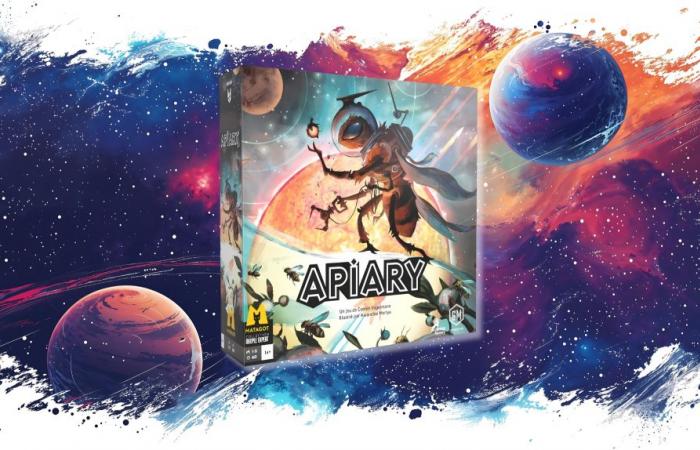Apiary, an (improbable) game where bees explore space . Optimize your workers and build the perfect hive.
Bast Martinez
Rather a fan of management and strategy games, Bastien likes a game to blow an epic wind in his face, like the podcasts “Des Mortels et des Dieux” that he hosts on Spotify and Souncloud
Apiary: The Universe of Galactic Bees
Warning : In the interest of transparency towards our community, we would like to clarify that this article reflects our personal opinion on the game. We have not received any compensation from the publisher of the game. We have acquired and tested the game independentlywith no commercial connection to its publisher. The reviews presented here represent our honest and unbiased analysis of the game, based on our own experience.
Apiary is set in a future where intelligent bees have replaced humans and set out to conquer space aboard their space hives.
You will find elements specific to bees (the workers, the queen, the pollen and the honey), as well as aspects of the world of science fiction (space exploration, technological innovations).
The first thing we can say is that this atypical mix works well! We quickly get carried away in this universe and we quickly want to move the queen’s ship to explore planets or build the best hive.
The rules of the hive
The goal of the game is to score as many victory points as possible by optimizing the use of your worker bees.
Apiary is a worker placement game. Workers are represented by four-sided bees, each side indicating the worker’s strength. Your workers will gain strength – and therefore efficiency – over the course of the game, but when one of them’s strength exceeds 4, they will have to leave the board and go into hibernation.
With a few exceptions, you have two options during your turn: place a worker on the board and perform the corresponding action, or recover your workers to activate the production of your farms.
Earning points can be done in several ways, but the most important is to expand your hive. Each player starts with a different board on which they can add tiles. These can be farms (for resource storage and production), permanent worker upgrades, innovations (powerful actions but limited to construction) or monuments (to optimize your points at the end of the game).
The choice of these tiles and their placement will be decisive in getting the maximum number of points.
In addition to building, you can explore planets to gain resources, trade resources, acquire seed cards or plant them to gain points, expand your territory or even call new workers.
One of the important aspects of Apiary is that you are almost never blocked by an opponent (unless he buys the tile you want). All actions are always possible (as long as you have the right strength), which allows you to plan your actions well in advance.
The strategy of the best workers
Apiary is a complex game that offers a wide range of possibilities at each turn. In addition, the large number of different factions (20) combined with the various boards (5) allows for many strategies.
That said, some elements seem to repeat themselves throughout the games.
Monuments are very large sources of victory points. They often give points based on the other elements on your board. Therefore, optimizing your tiles and the extent of your hive is crucial.
You have to build a lot, but you also have to think about how best to optimize your tile placement.
Your farms can be a regular source of points, so you need to have enough workers to keep them running. It is important to make sure you always have enough workers.
Finally, don’t underestimate the potential of certain seed cards or innovation tiles which can really give you an advantage during the game.
The pleasure of twirling in the game
Apiary is an interesting game with many possibilities that has the advantage of not lasting too long.
Indeed, the end of the game may seem far away during the first few turns, but most players send their workers into hibernation at the same time. And it is precisely these hibernations that trigger the end of the game.
Apiary is essentially a game of anticipation and optimization, which is interesting when you master its mechanics, but can be confusing during the first games.
Additionally, it can be frustrating to watch an opponent fly away in points without having a real chance to attack or counter them.
Beyond victory points, the game will offer you many small satisfactions: exploring planets, installing tiles to build your hive, inventing dances, etc.
Apiary, verdict
Should you get Apiary? The answer depends on what type of player you are. If you like to plan your moves in advance and not be surprised or disturbed by your opponents, then this game will suit you perfectly. Its relatively short duration (between 60 and 90 min, or even 45 min for 2) will even allow you to play several games in a row.
The universe is also a very important and very well-done aspect of the game. Its originality could cool some people, and the most skeptical could even wonder why these bees needed to go into space and couldn’t just go and pollinate the flowers in the field next door.
Thanks to its mechanics, the game plays just as well from 1 to 5. The automa (the bot for playing solo) is well designed and you can adjust its level for an even greater challenge.
However, while this lack of interaction may be a strong point for some, it is still one of the flaws from a personal point of view. During my games, I actually obtained about the same number of points playing against the automaton or against real people. But – and this is stupid to say – when I play board games, I expect precisely that the “society” with whom I share this moment influences my game.
Finally, Apiary is a game that deserves several plays. You will probably be lost during your first turns. It will take you time to understand which actions are important and what is the interest of certain mechanics (farms for example are used more for storing resources than for real production. You should rather use them to earn points and use planet exploration if you really need resources).
Regardless, it’s a game that deserves to be given a chance – and more than once!
Very good
Rating: 4 out of 5.
Note that the author, Connie Vogelmann, also created Wyrmspan, which we just told you about.
- Label The Green : No. To learn more about the Dé Vert label, click here.
- Creation : Connie Vogelmann
- Illustrations : Kwanchai Moriya
- Editing : Matagot
- Numbers of players and players : 1-5 (ideal at 1-3)
- Recommended age : From 14 years old (hardly less)
- Duration : 90 minutes
- Theme : Bees, science fiction
- Main mechanics : Placement, Tiles, Resources, Worker Placement. To learn more about the different game mechanics, click here.
Join our community:
Join our WhatsApp channel
Since 2007, your loyalty has shaped our gaming blog. To make your reading experience even more enjoyable, we have chosen an ad-free space, however we maintain affiliate relationships with Philibert and Play-in, we receive a small commission when you buy a game from our site. Our independence is fueled by your support, and every contribution, small or large, makes a real difference.
By donating via Tipee, you help us enrich our content and share our passion for board games. Your support allows us to continue this great adventure together. Thank you for your generosity and for being part of our community dedicated to games, in all its forms. Together, let’s continue to explore the gaming universe!
Support Gus&Co on Tipeee
Your reaction to the article?
I like this :
I like loading…






